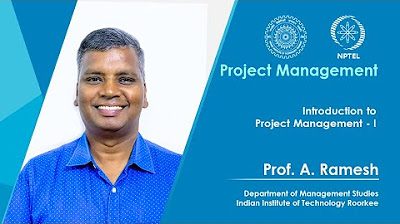Risk Management Basics | Google Project Management Certificate
Summary
TLDRThis video script delves into the intricacies of project management, emphasizing the inevitability of encountering hurdles and the importance of risk management. It outlines the distinction between risks and issues, advocating for proactive identification and planning to mitigate potential threats to a project's success. The script provides practical tools and techniques for risk assessment, such as brainstorming and the use of a probability and impact matrix, and discusses strategies for risk mitigation, including avoidance, acceptance, reduction, and transfer. It also underscores the critical role of stakeholder communication in managing expectations and ensuring project resilience.
Takeaways
- 📚 Project management often involves unexpected hurdles, emphasizing the importance of flexibility and risk planning.
- 🔍 A risk is a potential event that could impact a project, while an issue is an actual problem affecting task completion.
- 🛡 Risk management is an ongoing process of identifying, evaluating, and addressing potential risks and issues.
- 📉 Risks can threaten a project's goals, timelines, and success criteria if not properly managed.
- 📈 A risk assessment involves estimating the likelihood and impact of risks, often using a probability and impact matrix.
- 🤝 Brainstorming with a diverse team is an effective way to identify risks, leveraging various perspectives and experiences.
- 📊 A cause-and-effect diagram, or fishbone diagram, helps visualize potential causes of a risk, aiding in comprehensive risk identification.
- 📝 The risk register is a crucial tool for documenting and organizing the list of identified risks.
- ⚠️ Time, budget, and scope risks are common project challenges that need to be carefully managed to avoid delays and cost overruns.
- 🔄 Risk mitigation strategies include avoiding, accepting, reducing, controlling, or transferring risks to minimize their impact.
- 🗣️ Effective communication with stakeholders about identified risks and mitigation plans is essential for managing expectations and securing support.
Q & A
What is the importance of flexibility in project management?
-Flexibility is crucial in project management because it allows project managers to adapt to unexpected changes or hurdles that may arise, ensuring the project can still meet its objectives despite unforeseen circumstances.
What is the difference between a risk and an issue in project management?
-A risk is a potential event that could occur and impact the project, while an issue is a known or real problem that affects the ability to complete a task. Essentially, risks are hypothetical concerns, and issues are current problems that need to be addressed.
Why is risk management a continuous process in project management?
-Risk management is a continuous process because new risks can emerge as the project progresses, and existing risks may change in terms of their likelihood or impact. Regular risk management helps in identifying, evaluating, and addressing these risks effectively.
What are some common types of risks that project managers should be aware of?
-Common types of risks include time risks (tasks taking longer than anticipated), budget risks (costs increasing due to poor planning or scope expansion), and scope risks (project not producing the desired results).
How can a cause-and-effect diagram help in risk management?
-A cause-and-effect diagram, also known as a fishbone diagram, helps in identifying all the potential causes that could lead to a specific event or risk, allowing project managers to consider and address these causes to prevent the risk from materializing.
What is the purpose of a risk register in risk management?
-A risk register is a table or chart that contains a list of identified risks. It serves to document and organize the risks, their likelihood, impact, and mitigation strategies, ensuring that the project team has a clear overview of potential risks and how to address them.
How does a probability and impact matrix help in prioritizing project risks?
-A probability and impact matrix is a tool that helps in assessing the likelihood of a risk occurring and its potential impact on the project. By categorizing risks based on these two factors, project managers can prioritize which risks require the most attention and resources for mitigation.
What are the four common strategies for risk mitigation?
-The four common strategies for risk mitigation are avoiding the risk, accepting the risk, reducing or controlling the risk, and transferring the risk to another party.
Why is it important to communicate risks to stakeholders?
-Communicating risks to stakeholders is important to set expectations, demonstrate proactive risk management, and potentially gain additional insights or support from stakeholders that could help in managing the risks more effectively.
How should the communication of risks to stakeholders be tailored based on the severity of the risk?
-The communication of risks should be tailored based on the severity of the risk. Low-level risks might be communicated via email, medium-level risks may require direct emails or meetings, and high-level risks should be discussed thoroughly in meetings with detailed presentations of the risk and mitigation plans.
What is a single point of failure and why is it critical to manage it in a project?
-A single point of failure is a risk that has the potential to be catastrophic and halt work across the entire project. It is critical to manage it because it can stop all progress until resolved, impacting the project timeline, budget, and scope.
What is the role of a decision tree in risk mitigation planning?
-A decision tree is a flowchart that helps visualize the wider impact of a decision on the rest of the project. It assists in building mitigation plans by outlining potential risks and options for addressing them, allowing project managers to choose the most effective strategy.
Outlines

このセクションは有料ユーザー限定です。 アクセスするには、アップグレードをお願いします。
今すぐアップグレードMindmap

このセクションは有料ユーザー限定です。 アクセスするには、アップグレードをお願いします。
今すぐアップグレードKeywords

このセクションは有料ユーザー限定です。 アクセスするには、アップグレードをお願いします。
今すぐアップグレードHighlights

このセクションは有料ユーザー限定です。 アクセスするには、アップグレードをお願いします。
今すぐアップグレードTranscripts

このセクションは有料ユーザー限定です。 アクセスするには、アップグレードをお願いします。
今すぐアップグレード関連動画をさらに表示

CH05. L02. Test planning overview

SPM(Software Project Management) with real life examples

AP 10 ONLINE LECTURES: Aralin 8 "Community-Based Disaster Risk Management (CBDRM)"

Lecture 01: Introduction to Project Management - I

Project Management Life Cycle | #bscit #spm #bsccs

CH05. L06. Project and product risk
5.0 / 5 (0 votes)
